 Game: Epic Mickey 2: The Power of Two
Game: Epic Mickey 2: The Power of Two
Developer: Junction Point Studios
Publisher: Disney Interactive Studios
Available on: PlayStation 3, Xbox 360, PC, Wii, Wii U
Reviewed On: Xbox 360
Video Game Designer Warren Spector helped change the face of flight simulators with the Wing Commander games in the nineties. Then he changed the way that we play first person shooters with Deus Ex in the noughties. Now, he has set it upon himself to update and change our views on a Walt Disney game, challenging our preconceptions and trying to open up the world of Mickey Mouse and his friends to gamers of all ages. This began two years ago with Epic Mickey, but that game was only ever released on the Wii, and suffered from the being lost in a sea of children’s titles and casual games. It also struggled with an awkward camera and fiddly controls at the same time, but that hasn’t stopped Spector and his Junction Point Studios from working on a multi-platform sequel that looks to address some of these issues and hopefully find a larger audience for their title.
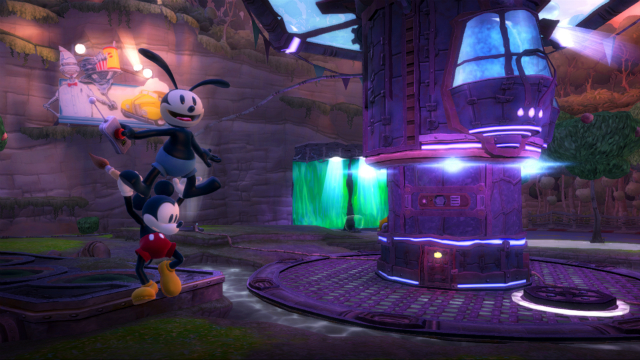
STORY: In the first game, Mickey found his way into the Wasteland, an alternate dimension where the forgotten Disney characters dwell. Here, Mickey battled a mad scientist who was intent on taking Mickey’s heart and escaping the Wasteland. The scientist was teaming up with the Blot, an ink-like creature who could create minions to send out after Mickey, and Oswald the Lucky Rabbit, the very first Walt Disney character, who had grown jealous of Mickey’s success. With the help of a reformed Oswald and Gus, a helpful Gremlin, Mickey defeated the scientist, but the Blot has somehow survived. That is how we begin the second game. Now even the mad scientist realises the dangers the Blot poses to the Wasteland, and he promises to change his ways and help both Oswald, and a returning Mickey, to defeat the Blot once and for all.
If this doesn’t make a whole lot of sense to you, then you won’t be alone. One of the main issues with the story in Epic Mickey 2 is that the game isn’t friendly to those who didn’t play the first game. Considering that the first only came to the Wii and now this sequel has been released on several platforms, you would at least expect a bit of a recap movie to bring players up to speed and to help make sense of what is going on in this game. There are cursory mentions made, and some characters will refer to events from the past game, but this is too little really, and most gamers will be left a little cold by the story as a result.
In an interesting move, a lot of the story is told by the medium of song as the designers of the game have tried to give it the feel of an old Disney musical. This is a very funny idea, and the fact that the mad scientist seems to be the main participant in the singing turns conventions on their head a little, however, after the third or fourth cutscene you may begin to get a little fed up with the slow pace of the singing, and just wish that the scientist would speak his lines and get on with the story! The game doesn’t become the full-on musical that Spector had spoken about during production of the game, and perhaps this was a small mercy, as one could see that this could have become very trying.
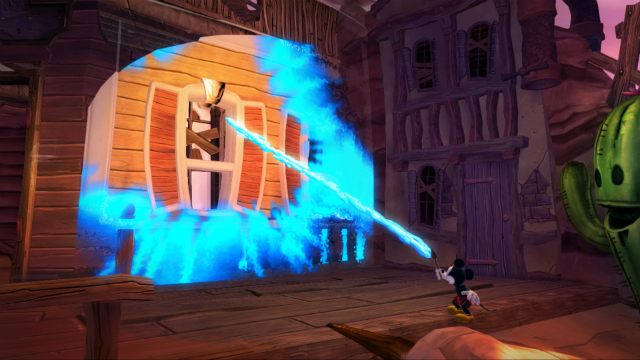
GRAPHICS: Being available now on high-definition platforms as well as the Wii, Epic Mickey 2 is even more of a visual delight than the first. The in-game graphics are crisper and more intricate than before, and the levels are packed full of detail whereas, previously, some areas where quite flat at times in comparison. The character animations remain top-notch, as you would want to see in a Disney game, and the exaggerated cartoon-style movement suits the mood perfectly. The game world is very creative, being an alternate version of the real-life Disneyland; albeit with dilapidated buildings and ruins scattered throughout. As a result, there are a lot of references to Disney films and little touches that hardcore Disney fans are likely to get a kick out of, hidden in the design of the areas.
This is particularly true of the mini, side-scrolling levels that are based on old Mickey Mouse cartoons; these are a really authentic love letter to classic cartoons. Then there are the cutscenes, some are produced in the game engine, and these look very clean, like a CGI Disney movie, but what will really grab gamers are the drawn cinematic videos. These were outsourced to the same animation studio who worked on the first game, and are drawn in a real retro style, full of expression and character. These have a real charm about them, and make us feel like we are part of an interactive cartoon even more so.
SOUND: As was the case with the award-winning soundtrack for the first game, the musical score is once again a joy to hear. By mixing traditional and well-known Walt Disney Studio music and themes, with newly written dramatic music, the sound team have created a soundtrack that is both original and familiar, and one that also shows of the in-game contrast of good and evil, of new and old. This helps perpetuate the ideas that the game is trying to convey to gamers, and makes the gameplay experience a deeper one. Of course, the positives of the sound design also spans to voice and sound effect work, as the company has access to Disney sound banks, and many of the regular character voice artists also reprise their regular roles as Mickey Mouse, Goofy and other such well-loved cartoons.
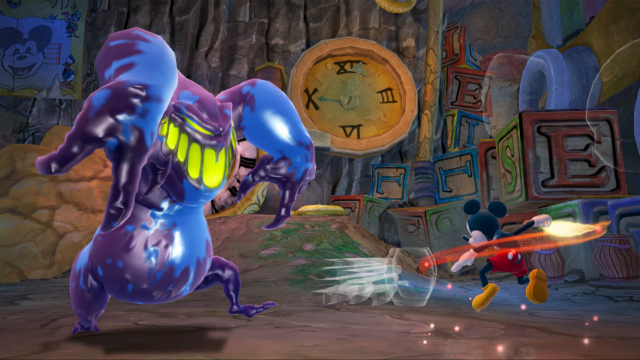
GAMEPLAY: The game is primarily a platforming title, which will see a player control Mickey and be accompanied by either an A.I. or player-controlled Oswald. The two characters make their way through Wasteland, defeating Ink Blots and crazed machines and restoring the world to its former glory. But this is where the main thrust of the game lies. Mickey is armed with a magic paintbrush that he can use in two ways. He can apply paint or thinner to objects and environments. Using paint will restore broken objects to their full glory, fill in invisible objects, or turn enemies into friends. Thinner will erase walls, destroy platforms and dissolve bad guys. Using one stick to move your character, and the other to aim your weapon, the control method is actually quite precise and intuitive. The direct control of the analog sticks actually providing much tighter control than Wii Remote motion controls in the first game (although these have apparently also been tightened up for this sequel).
The interesting theory behind the paint and thinner balance is that both levels and other characters will react to how you choose to tackle levels. For example, if you choose to paint enemies and befriend them, not only will they then help you to fight other bad guys in the area, but other characters across the game world will see your mercy and treat you better; perhaps even rewarding you. On the other hand, if you choose to get through a level by erasing walls and floors to create shortcuts, you may end up causing irreparable damage to the area, and when you re-visit the level at a later point, it will remain damaged and some areas can become permanently out of reach. You must choose wisely where and when to use paint, and when to use thinner. This is really interesting, introducing elements of morals and conscience into the game as well as cause and effect. The game world can really be morphed by your actions, which is really interesting to see as it develops.
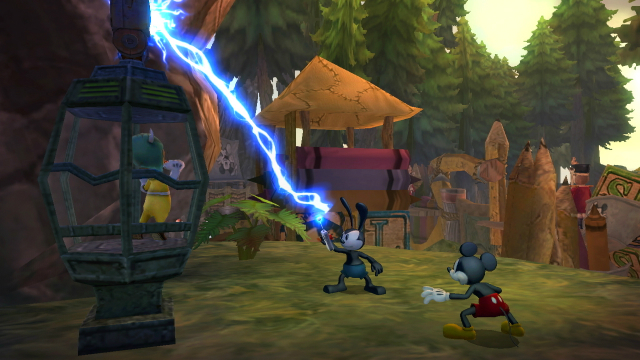
Oswald on the other hand has a remote control, that he can use to zap buttons and re-program evil robots, as well as a boomerang arm, which he can throw to collect or activate distant items. There isn’t the same good versus evil balance with Oswald’s powers, and there aren’t the same big issues to consider either when using his actions; Mickey carries all of that responsibility in the game. There are also two new inks found across the game world that both characters can make use of. These are wells of Invisible and Indelible Inks. Jump into the well and you will either become temporarily invisible to all enemies whilst you walk slowly (move too fast and you will become visible again), or become indelible, temporarily hardened and invincible to some attacks and environmental hazards. These are mainly used for very specific puzzles or sections of the game though, so if you see a well, you will know there is something nearby that it is needed for. This does give the impression that your hand is held a little too much and makes knowing when to use the inks a little too straight-forward.
The main issue with the game is probably the very hit and miss artificial intelligence for when Oswald is computer-controlled. On some occasions, he seems to automatically know what you want him to do, and hop to it right away For example, to get through a door, you may need him to zap a control panel with his remote. When the A.I. works well, Oswald will see that you are near the door, and zap it automatically. Then there are occasions where he will instead see that you are near the door so a thought bubble appears above his head, asking if you want him to zap the panel. A quick tap of a button to confirm that you do and he will open the door for you; this is a kind of middle ground. However, there may be a point when you come to another door – very similar, activated in the same way – yet you will have all sorts of difficulties to get it open. Oswald might run around in circles, or get stuck trying to follow you and fall down a hole. Sometimes, he just takes forever to arrive and when he does, he might just stand still and not offer to help. This obviously can be a huge annoyance, and we start to experience the same problem that blights many co-op-centric games when played in single-player.
Unfortunately, the camera issues that plagued the first game may have been tweaked a little for this sequel, but they still remain somewhat of a problem. You can now control the camera much more easily, and it doesn’t constantly get dragged all over the place by the action on-screen any more. Using the dual sticks on a control pad, you move the screen as and when you want, so it makes a lot more sense than the director-controlled camera in the first game. But the issue now is that more often that not the camera defaults into a very low angle, pulling everything literally down to a mouse-eye view, and making a lot of navigation quite difficult. Imagine trying to jump across several platforms if your eyes were on your feet. It’d be pretty confusing to say the least. In boss battles, the same old problems return, where the camera will swing around by its own accord, making the game more of a motion-sickness simulator than anything else. We were told that the camera issues were fixed, however they have instead just changed a little bit.
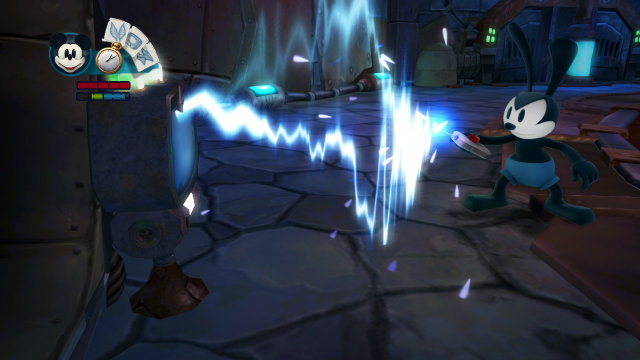
MULTIPLAYER: The split-screen co-operative mode is where the game actually really comes to life. Whereas shaky artificial intelligence may have hindered your single-player playthrough, going through the story with a friend can be an altogether more fun and functional experience. You no longer have to wait and hope Oswald will come to you and activate the buttons that you wish; now you can really help each other and work together in a much more effective manner. Strangely, the co-op is not available online, perhaps the social aspect of couch co-op was considered an important part of the Epic Mickey 2 co-operative experience, but the developers have perhaps missed a trick a little by not at least offering gamers that choice of playing online if they so wished.
LONGEVITY: It must be said that the game is actually very lengthy. Even ignoring all of the side-quests and optional extras such as collecting artefacts and taking photos, the main story missions will last a long time and players could easily see themselves taking well over twenty hours to complete the campaign. Now this may not all be because there is lots to do, part of it is down to the fact that the tasks are repetitive and require quite some back-tracking from time to time. The main missions and side quests will begin to become quite similar if you try to complete them all, and many gamers may not have the patience to complete every single task on offer for this very reason. The fact that so many missions involve fixing pipes or opening valves becomes quite tiresome, and it is a real shame that some more imaginative missions could not have been created for such a complex and interesting game world. This was an issue in the first Epic Mickey, and has reared its ugly head again for Epic Mickey 2.
Some of the extras are quite fun though, such as hunting for Hidden Mickeys or Oswalds – items or areas of the park that appear similar in shape to the head of either Mickey or Oswald – which must be photographed. This is in reference to the real-life hobby of looking for Hidden Mickeys in Disney theme parks and, as such, will amuse Disney buffs but will most likely go over the heads of other players. Other side quests just aren’t enjoyable enough to warrant going through and to collect all items, you will actually have to go back and re-play some of the stages, entering from different points in order to collect different objects. This seems more like hard work than fun, as most of the levels will be quite boring after the first play-through. The length of time you spend on the game will therefore depend on how many of the optional tasks you choose to complete, but it will keep any player busy for quite a long stretch.
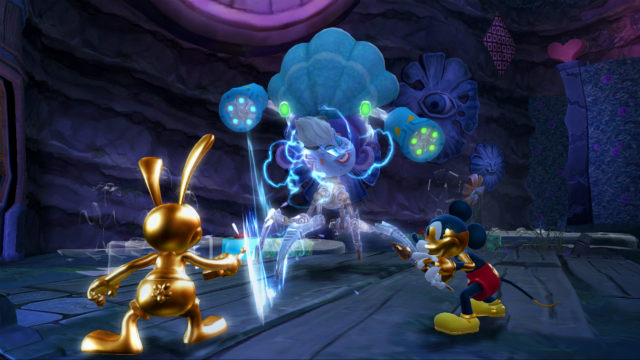
VERDICT: The game is a real mixed bag, which is unfortunate as the concept and design of the game and its world is really creative. The art style is stunning, and will surely grab the attention of players and tempt them to try the game, despite the still-present pre-conceptions that a Disney game will be meant only for kids. The music and sound design is also quite beautiful, helping immerse the player even further into the game. The co-operative play is also a lot of fun, and the game deserves to be played along with a friend. But then you have to weigh it up against the weaknesses, both those that have carried over from the original game, such as the temperamental camera and lack of variety in missions, and the new issues, mainly the often lax artificial intelligence.
That is perhaps a little too harsh in reality. The game has attempted a lot of interesting ideas, which might not all come off one hundred percent, but are bold ideas for what many will see as a children’s title. Being able to change the world and people around you by the way you choose to act is something that is still a bit of a novelty in games. Too many titles let you destroy a skyscraper, only to see it respawn when you return to the area later. Your actions really have an effect on the Wasteland, and there are so many different ways in which the world can be morphed and altered, giving gamers a lot of room for experimentation. Throw in the very solid two-player mode, and the game is far from a failure; although it doesn’t manage to deliver on all its promises.







